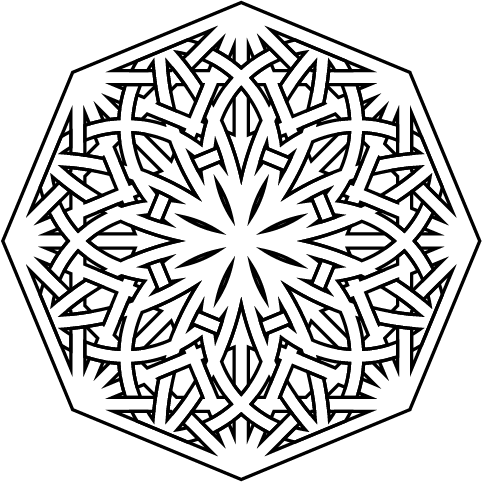Hyperbolic Geometry in Art
Share
The Geometry of the Infinite
I. The Problem of Parallel Lines
To understand the intersection of math and art, we must first understand the shape of space. For two millennia, Euclidean geometry reigned supreme. It assumed space was flat—like a sheet of paper. In this world, the angles of a triangle always add up to 180 degrees, and parallel lines never meet.
However, in the 19th century, mathematicians like Lobachevsky and Bolyai discovered a new kind of space: Hyperbolic Geometry. Imagine a surface curved like a saddle or a ruffled kale leaf. In this space, the angles of a triangle sum to less than 180 degrees, and space expands exponentially as you move away from the center.
II. The Escher-Coxeter Connection
Visualizing this "negative curvature" on a flat 2D surface is impossible without distortion. This mathematical hurdle was solved by Henri Poincaré, who developed the Poincaré Disk Model. In this model, the entire infinite hyperbolic plane is compressed into a finite circle.
The Rules of the Disk
In the Poincaré model, straight lines appear as arcs orthogonal to the boundary. As objects move toward the edge of the circle, they appear to shrink. Mathematically, they remain the same size; it is the "ruler" measuring them that shrinks. This creates a visual representation of infinity contained within a finite boundary.
This model remained an obscure curiosity until 1958, when the Dutch artist M.C. Escher received a letter from the geometer H.S.M. Coxeter. The letter contained a diagram of a hyperbolic tessellation.
Escher, who had been searching for a way to capture infinity without simply "cutting off" the edges of his work, was electrified. This collaboration led to his famous Circle Limit series.
III. Computational Archaeology: Revealing Intuited Math
Escher constructed his hyperbolic worlds from scratch. But what if we reverse the process? What if we use modern algorithms to project existing historical art into hyperbolic space?
At Pardesco, we utilize the Poincaré disk model as a lens for art history. We posit that artists creating mandalas, knotwork, and sacred tilings were attempting to depict the infinite. By mapping their work onto hyperbolic tessellations, we can see the geometry they felt but couldn't calculate.
Case Study A: Albrecht Dürer (1521)
Albrecht Dürer studied the "academical knots" of Leonardo da Vinci. His 1521 embroidery patterns feature a grid of six-pointed stars. In Euclidean space, this pattern repeats endlessly. However, when we map it to a {6,4} Hyperbolic Tessellation (where six squares meet at a vertex), the pattern takes on a new life.

Case Study B: Tibetan Cosmology (14th Century)
Buddhist cosmology describes a universe of "infinite buddha-fields." A traditional thangka painting is a window into this infinite space. The Chakrasamvara mandala is recursive by nature—deities emanate from deities.
When we apply a {4,7} Tessellation, we mathematically validate the theological concept. The central deity does not just sit in the center; they generate a geometry that propagates endlessly toward the event horizon of the circle.

The Infinite Emanations
Source: Tibet, late 14th century. The {4,7} symmetry suggests a universe expanding faster than Euclidean physics allows.

Surya's Infinite Chariot
Source: Nepal, 1379. The cyclic nature of time represented by the Sun God is transformed into an infinite spiral.
IV. Conclusion
The hyperbolic transformations presented here are not merely distortions; they are translations. Just as a translator converts text from one language to another to reveal meaning, we convert geometry from Euclidean to Hyperbolic space to reveal intent.
This research suggests that the human intuition for the infinite—found in German Renaissance workshops and Himalayan monasteries alike—preceded the mathematical formulas required to describe it by centuries.
Browse the full collection of hyperbolic transformations and limited edition prints at the Pardesco Gallery.
View the Collection →